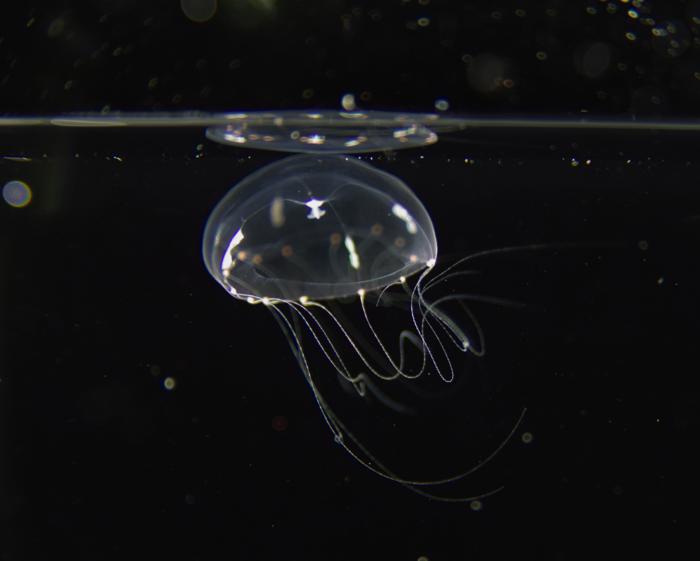Scientists have made a groundbreaking discovery regarding the development of jellyfish embryos, providing compelling insights into the essential mechanisms that shape their body plans. In this enlightening study, researchers focus on the jellyfish species Clytia hemisphaerica, revealing fundamental processes that govern the establishment of a central axis in these creatures from head to tail. This research, published as a Reviewed Preprint in the prominent journal eLife, underscores the significance of understanding such biological phenomena that date back to early multicellular organisms.
The evolution of complex body structures in animals has fascinated scientists for decades. Traditional models focus heavily on larger, more complex organisms; however, the relatively simpler structure of jellyfish larvae presents a unique opportunity to unravel the mysteries of primordial body plan development. This investigation sheds light on the role of Wnt signaling within the embryonic stages of jellyfish, a critical pathway that many animals utilize to establish cellular communication and facilitate proper development.
During embryogenesis, a crucial step is the establishment of the body axis, which dictates the future orientation and organization of opportune features such as the mouth and tail. An intricate network of proteins known as Wnt signaling has long been recognized for its role in guiding cell differentiation and instructing cells on growth direction. The current study delves into how jellyfish use Wnt signaling, specifically focusing on Wnt3, to define their body plan and emphasize the dynamics of cellular organization.
At the outset of their research, the team led by Julie Uveira, a laboratory engineer at the CNRS/Sorbonne University, explored jellyfish embryos devoid of Wnt3 activity. It was found that embryos lacking this protein exhibited chaos in their body organization, with a notable absence of a central axis. Furthermore, observations indicated that cellular boundaries were poorly defined and lacked the necessary tension, resulting in an amorphous cellular structure. This observation was crucial as it indicated that Wnt3 is not merely a participant in the process, but rather a pivotal player in the functionality of embryonic development.
In their experimentation, the team sought to restore normal body structure by reintroducing Wnt3. Remarkably, upon reintroduction, the correct body shape was achieved, reinforcing the understanding that Wnt3’s influence extends well beyond mere cellular signaling; it encompasses significant roles in physical morphology and structure. This two-pronged regulatory mechanism is pivotal for sustaining the integrity of the jellyfish body form during its early stages of development.
The research further investigates the relationship between Wnt signaling and Planar Cell Polarity (PCP). This newly uncovered relationship has profound implications for understanding how jellyfish embryos organize cells in a coordinated manner, a requirement for fabricating their elongated ‘torpedo’ shape. Through advanced fluorescent imaging techniques that highlighted cilia, the team unveiled that Wnt3 triggers a concerted alignment of cells, encouraging them to collectively orient towards one end of the larva.
As cellular organization progressed, the entire body structure gradually became unified, showcasing a well-aligned axis. Interestingly, this polarity was shown to foster not only cellular coherence but also impart mechanical tension, which is quintessential for the characteristic shape of the jellyfish larva. This detailed involvement of Wnt3 in coordinating cellular organization signals a refined orchestration of developmental cues that could be traced back through evolutionary history.
Separate from its interactions with β-catenin—a well-known player in Wnt signaling pathways—Wnt3 exhibited the ability to instigate PCP polarization independently. Through targeted experiments that blocked β-catenin while maintaining Wnt3 functionality, researchers demonstrated that Wnt3 could still direct development. Conversely, this directed axis development depended heavily on the presence of PCP proteins, shedding light on the modular roles Wnt3 plays, which can substantially differ based on contextual cellular environments.
These findings illustrate a two-step development process: the initial step in which Wnt3 shapes the prospective mouth area and enacts directional guidance for the axis, followed by a secondary role that activates a cascade promoting polarity throughout the embryo. A newfound clarity about how primordial animals navigate developmental pathways affords researchers a unique frame of reference when studying the evolution of body plans across a spectrum of species.
The implications of this research extend far beyond the immediate context of the jellyfish. Establishing a common framework for understanding how foundational developmental processes appear across various evolutionary pathways can illuminate why certain traits persist over time and how such characteristics might have arisen. Comparatively analyzing cellular organization mechanisms in divergent evolution can also reveal crucial insights regarding the adaptability and survival of species.
As the field of evolutionary developmental biology continues to evolve, there’s an increasing call to delve into the minutiae of cellular organization. The findings from this study represent a vital step in recognizing the biological threads that interweave simplicity in early organisms with complexity in advanced multicellular life forms. The conversations about cellular polarity and its role in animal development could indeed redefine how researchers approach the inherent complexity of life.
In summary, this remarkable research has opened avenues for additional exploration into the fabulous world of marine life and the evolutionary pulse that defines it. As scientists continue to navigate the intricacies of biology and evolutionary history, insights drawn from these simple yet profound creatures will undoubtedly enrich our understanding of life’s fundamental patterns.
Subject of Research: Jellyfish Embryology and Body Plan Development
Article Title: Planar cell polarity coordination in a cnidarian embryo provides clues to animal body axis evolution
News Publication Date: 28-Jan-2025
Web References: eLife
References: DOI: 10.7554/eLife.104508.1
Image Credits: Tsuyoshi Momose
Keywords: Developmental biology, Evolutionary development, Wnt pathway, Cell polarity, Jellyfish embryology
Tags: cellular communication in jellyfish larvaecentral axis establishment in jellyfishClytia hemisphaerica body planevolutionary biology of simple organismsgroundbreaking research in developmental biologyinsights into multicellular organism developmentjellyfish embryonic developmentjellyfish larval morphologyprimordial body plan mechanismsrole of proteins in jellyfish axis formationsignificance of embryogenesis in marine speciesWnt signaling pathway in embryos





